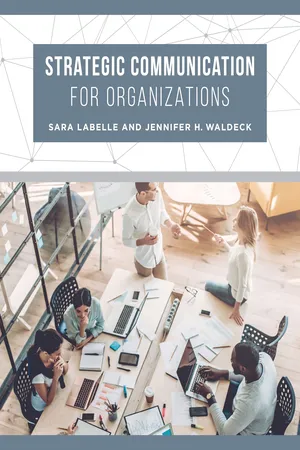
- 368 pages
- English
- ePUB (mobile friendly)
- Available on iOS & Android
eBook - ePub
Strategic Communication for Organizations
About this book
Strategic Communication for Organizations elucidates the emerging research on strategic communication, particularly as it operates in a variety of organizational settings. This book, appropriate for both students and practitioners, emphasizes how theory and research from the field of communication studies can be used to support and advance organizations of all types across a variety of business sectors. Grounded in scholarship and organizational cases, this textbook:
- focuses on message design
- provides introductory yet comprehensive coverage of how strategy and message design enable effective organizational and corporate communication
- explores how theory and research can be synthesized to inform modern communication-based campaigns
Strategic Communication for Organizations will help readers discuss how to develop, implement, and evaluate messages that are consistent with an organization's needs, mission, and vision, effectively reaching and influencing internal and external audiences.
Frequently asked questions
Yes, you can cancel anytime from the Subscription tab in your account settings on the Perlego website. Your subscription will stay active until the end of your current billing period. Learn how to cancel your subscription.
No, books cannot be downloaded as external files, such as PDFs, for use outside of Perlego. However, you can download books within the Perlego app for offline reading on mobile or tablet. Learn more here.
Perlego offers two plans: Essential and Complete
- Essential is ideal for learners and professionals who enjoy exploring a wide range of subjects. Access the Essential Library with 800,000+ trusted titles and best-sellers across business, personal growth, and the humanities. Includes unlimited reading time and Standard Read Aloud voice.
- Complete: Perfect for advanced learners and researchers needing full, unrestricted access. Unlock 1.4M+ books across hundreds of subjects, including academic and specialized titles. The Complete Plan also includes advanced features like Premium Read Aloud and Research Assistant.
We are an online textbook subscription service, where you can get access to an entire online library for less than the price of a single book per month. With over 1 million books across 1000+ topics, we’ve got you covered! Learn more here.
Look out for the read-aloud symbol on your next book to see if you can listen to it. The read-aloud tool reads text aloud for you, highlighting the text as it is being read. You can pause it, speed it up and slow it down. Learn more here.
Yes! You can use the Perlego app on both iOS or Android devices to read anytime, anywhere — even offline. Perfect for commutes or when you’re on the go.
Please note we cannot support devices running on iOS 13 and Android 7 or earlier. Learn more about using the app.
Please note we cannot support devices running on iOS 13 and Android 7 or earlier. Learn more about using the app.
Yes, you can access Strategic Communication for Organizations by Sara LaBelle,Jennifer H. Waldeck in PDF and/or ePUB format, as well as other popular books in Languages & Linguistics & Business Communication. We have over one million books available in our catalogue for you to explore.
Information
PART 1
FOUNDATIONS OF STRATEGIC COMMUNICATION
CHAPTER 1
An Introduction to Strategic Communication

CHAPTER CONTENTS
1.1The Need for Strategic Communication in Organizations
1.2Laying the Groundwork: Communication as a Foundation for Organizational Success
1.2.1Defining Communication
1.2.2A Linear Model of Communication
1.2.3The Simultaneous Transactions Model of Communication
1.2.4The Study of Communication
1.3A Strategic Communication Approach to Organizations
1.3.1All Organizations Engage in Strategic Communication
1.3.2Strategic Communication Is Mindful Communication
1.3.3Strategic Communication Is Inherently Interdisciplinary
1.3.4A Strategic Communication Approach to Organizations Focuses on Messaging
1.4Tying It All Together: The Benefits of Applying a Strategic Communication Perspective to Organizational Processes
LEARNING OBJECTIVES
After reading this chapter, you should be able to do the following:





Jacob is a recent college graduate. Armed with a degree in business and a passion for entrepreneurship, Jacob has developed an environmentally friendly home cleaning product, EcoCleanR. He is thrilled to finally pursue his passion by founding his own start-up company to manufacture and distribute the cleaner. At first, things are going great: Jacob has a small team of talented college friends who are helping him with design and manufacturing, and his family and friends are happy to help buy EcoCleanR and talk about it in their own social networks. After a few months, though, the excitement and energy levels are waning for Jacob and his small—and burned out—staff. Sales are also dropping; the friends and family that initially bought and used EcoCleanR are still supportive, but Jacob needs to reach new audiences if he wants to continue to sell this product. What makes matters worse is that a large manufacturer has just announced a new sustainability initiative and launched products that have similar ingredient profiles to EcoCleanR. The pressure of this announcement is causing stress on his staff, who are not sure how Jacob’s product is unique or better than the competition.
Unfortunately for Jacob, the competition for EcoCleanR seems never ending . . . but the money and time are.
Facing pressures from both in and outside, Jacob realizes he needs a plan to help his start-up get back on track. He creates a list of things he needs to change for his company to succeed in an ever-changing market. First, he needs to get everyone in his company to agree on the identity and mission of their company, and the benefits EcoCleanR offers relative to the competition (both including and beyond the giant manufacturer initiative). Second, he needs to reach new audiences outside of his social and personal networks. Third, he needs to allocate funds for additional employees to lighten the current load on his overworked staff. All of these messages will require Jacob to communicate carefully and strategically to achieve his intended goals.
The stakes are high. If Jacob is successful, he can continue his passion for this product and seek investments to grow his company. If he isn’t, it is back to the drawing board.
What would you do if you were in Jacob’s situation? As you read about the challenges EcoCleanR faces, you may have had some ideas for how he can achieve his goals based on your own experiences, or experiences of friends and family. The truth is that the tasks that Jacob faces will require a complex understanding of his organization and the many people who are a part of it—or that he needs to be a part of it. Take a moment to think about the word organization. What comes to mind? Do you think of small organizations like Jacob’s start-up, or larger corporations that dominate international retail markets? You might think of the various organizations you or your family and friends have worked for, like the local stores and restaurants in your hometown. You might think of governmental agencies that have affected you and the decisions you make, such as the Environmental Protection Agency or the Department of Education. You might even have a positive or negative bias toward the term organization. On the other hand, you might be considering organization to be a skill or act—one that you might be especially good (or bad) at performing! By definition, organization is both a noun and a verb:
•As a noun, an organization is an identifiable social structure consisting of members united toward meeting either an external or internal need or pursuing a collective goal. Typically, these structures have management or leadership processes in place to help coordinate members and direct their action as well as to determine roles and responsibilities.
•However, the term organization when used as a verb also implies a preventive and reactive process, in which individuals or groups of people anticipate and adapt to change to function effectively. Organizing in this sense is the act of breaking down a larger problem into a series of achievable tasks.
Together, both the noun and verb elements of organization imply a process. This process might including arranging various parts into a structured whole (as in the case of uniting employees toward a common goal) or coordinating various elements for an event or activity (as in planning a wedding party for a group of two hundred guests). Anyone with siblings knows that the process of organizing is rarely simple or quickly done. Think back to when you were a child and your parents tried to organize your family to get in the car to go to a family party. As “managers,” your parents likely set time limits and boundaries (“we are leaving no later than 10:00 A.M.” “you can take one toy!”) that were perhaps followed by some “members,” but not all. If you were the oldest, you may have been frustrated at these boundaries, or even at your younger siblings’ inability to adhere to them. A number of complications likely arose in getting into the car, such as a misplaced shoe or a last-minute trip to the restroom. The process of organizing a group of children to get them from one location to the next is riddled with complications and requires complex orchestration of tasks and emotions. As defined by merriam-webster.com, this process of organizing ideally results in a coherent, united, whole product made of interrelated and interdependent parts—and as any communication scholar will add, this process is built on a complex set of interactions, both opposing and complementary needs among members, and an understanding that that organizing is an ongoing activity (Cooren, Taylor, and Van Every 2006).
Similar to families, organizations are not static entities. They must continually react to internal and external forces to survive (see Zorn 2010). Whereas for a family these forces might include anything from sibling rivalries to a visit from grandma and grandpa, for organizations these forces might include budget cuts, a changing economy, and a wide variety of emerging competitors. In fact, these continual alternations and modifications are as much a part of organizational life as stability and consistency (Weick 1995). In the modern world of globalization, big data, and rapidly evolving technology, flexibility and adaptability are essential requirements of organizational functioning. Organizations are not closed systems or isolated islands; they are highly affected by, and affect, their local, global, and even mediated environments. As Jacob’s experience illustrates, organizations not only face political, social, environmental, and personal influences; they ARE political, social, environmental, and personal influences. With these influences and pressures, there are a number of continual stressors and challenges that face organizations and those working for them. How organizations choose to communicate with members both in and outside of their organization in addressing these challenges is often the difference between success and failure.

Figure 2 We engage in organizing throughout our lives, and for many different purposes.
In this introductory chapter, we will discuss the many influences that inform a strategic approach to organizational communication. This will include a discussion of the field of communication studies as a whole as well as the principles that distinguish strategic communication from other areas of study. Ultimately, this chapter concludes by outlining four foundational assumptions of strategic communication approach to understanding organizations. We begin by discussing the need for st...
Table of contents
- Title
- Copyright
- Contents
- Acknowledgments
- Introduction: What to Expect from This Book
- Part One: Foundations of Strategic Communication
- Part Two: Creating, Implementing, and Evaluating Strategic Messages
- Notes
- Index